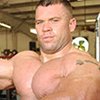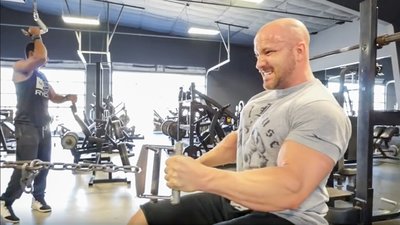In a bodybuilding contest, the elusive V-taper—coupled with a thick, detailed upper back— separates the truly memorable physiques from the rest of the pack.
If you want your back to grow and are willing to put in the time and effort, these four game-changing exercises are for you. Coupled with some unique intensity techniques, they'll help you maximize strength and hypertrophy while giving you the tools for these top exercises for back building workouts.
You can put all four movements together in a single workout for an incredible change of pace from what you normally do for your back.
1. Snatch-Grip Deadlift
The snatch-grip deadlift is a favorite of strength and conditioning demigod, Charles Poliquin. When Sir Charles talks, I listen—and so should you!
About The Movement
Olympic lifters typically aren't known for their muscular development—except for their upper backs. With the snatch-grip deadlift, the wider grip forces you to increase recruitment of your upper back muscles, traps, and rear delts—making it one of the most effective width-building exercises around.
Do It Right
Olympic lifters are basically gymnasts with barbells in their hands. Since our objective here is to build size and strength, we'll modify that wide grip and go with some precise grip-width guidelines I picked up from strength coach Anthony Mychal. The grip position matches with your height and assumes you don't have disproportionately long or short arms:
- 5'6" and shorter: Pinky on or just inside the last ring
- 5'7" to 6'1": Index, middle, or ring finger on the last ring
- 6'2" and taller: Index finger on or outside the last ring
We're going to start the movement at mid-shin level because pulling a traditional deadlift off the floor takes more mobility than you may have at the moment. As you master this movement, slowly work your way down to the floor.
Training Tips
- Perform this move when you're fresh.
- Aim for 3 sets of 5-8 reps.
- Always perform this movement with an overhand grip for safety and effectiveness.
- This is not a grip test. Wear straps.
2. 2-Up-1-Down Eccentric Seated Cable Row
This move formed part of Dorian Yates' "eccentrics" workout, meaning overloading the negative phase of an exercise, usually by performing a negative rep with a slow tempo. Do the same and, while you may not pose on the Olympia stage, you will take your back development to a new level.
About This Movement
Eccentric training is a great way to build strength and add slabs of muscle, thanks to a combination of satellite cell proliferation, preferential fast-twitch muscle recruitment, greater mechanical tension, ability to perform more volume, and even enhanced mind-muscle connection.
If eccentric-emphasis training is like driving on the interstate, my 2-up-1-down technique is like racing in the Daytona 500! It's also an awesome way to eccentrically overload your back—without needing anyone else's help!
Do It Right
Do a normal v-handle seated cable row as you normally would, pulling the handle into your abdomen. Then, do the negative with one hand only, and make it last 5 seconds. Do 3-5 reps like that, then do 3-5 more using your other arm for the 5-second eccentric. (Make sure it's the same number for each side.) Boom—that's 1 set!
Training Tips
- A great starting point is to use 70 percent of the weight you'd normally use for a strict set of six normal repetitions.
- This exercise needs to be heavy—and you need to maintain perfect technique without undercutting the prescribed tempo.
- This exercise is not a grip test! If you need to use straps, wear them—but only on the side you're working. Using straps on both sides just gets too cumbersome.
3. Mechanical-Advantage Dropset Pull-ups
The upper-body squat, a.k.a. the pull-up, has been an exercise mainstay for virtually every person who has ever graced a championship stage. These squats are also at the core of SWAT and special forces fitness tests, and they're one of the more popular moves among grapplers and cage fighters. If this variation doesn't convince you to start incorporating pull-ups into your routine, I don't know what will!
About This Movement
The idea here is start with your strongest pull-up grip—say, a wide grip—and knock out as many reps as you can. Rest 10 seconds. Move on to your second strongest grip—say, a chin-up—and do as many reps as you can. Rest 10 seconds. Finally, choose your third strongest grip—say, neutral grip—and do as many reps as you can. Repeat this sequence three times.
Training Tips
- If you can do more than 30 reps over the mechanical advantage sequence, get out the belt and strap on some additional weight.
- If you do less than 10 reps, use band assistance.
- Use a full range of motion—and no kipping!
- Get creative and try other pull-up variations. Always start with the most difficult and end with the easiest.
4. Banded Reverse Rows
I first saw this back exercise in a 1990s issue of the (now defunct) magazine Powerlifting USA. It was pioneered by powerlifters who wanted back movements that would specifically transfer to the bench press.
About This Movement
It would be reasonable to call this movement a bench pull on an inverse bench press.
Do It Right
Tie two bands to the top of a power rack, then put the barbell through the bands so it is suspended in the air. Lie down and grab the bar like you're going to bench press it. Now use the musculature of your upper back to pull the barbell to your chest. Hold the contraction for a second and repeat for 8-12 reps for 3-4 sets.
Training Tips
- There is a time and a place for cheating, but this is not that time or place! Keep the movement strict by explosively pulling the barbell to your chest while keep your body in contact with the bench.
- To add more resistance tie the bands to a higher point, use stronger bands, or even double the bands.
- Do the opposite to decrease resistance.
- If you can't tie the bands to a higher point and you don't have stronger bands on hand, just tie a knot or series of knots in the band to increase resistance.

